Updated 1/22/2021
This primer explains how to make creamy sorbet with or without an ice cream maker, and takes a closer look at the necessary (and optional) ingredients to ensure sorbet success every time. There are even sugar-free sorbet recipes!

The colors and flavors of sorbet are endless and oh so welcome on hot summer days. Some are very sweet, others are more mellow, tart, or even savory. Some boast floral, herbal, or spicy notes. There are even adult-only boozy sorbets.
In addition to the wide range of sorbet deliciousness, you may have noticed there are several methods for its creation, with varying textural results. This whole topic can be down right confusing. I was fairly confused until I did many hours of research, and tested 20+ batches, to sort it all out. Now that I have it straight, I’d like to share what I’ve learned with you 🙂
THE GOLDEN RULES
Too little sweetener and your sorbet will be icy; too much sweetener and it will be mushy.
Churn or stir your sorbet while it’s freezing to prevent large ice crystals from forming.
Please note the “Easy (no keep)” method doesn’t require any sweetener or churning/stirring.
The Secret to Making Creamy Sorbet
If you freeze blended fruit or juice as is, you’ll end up with a hardened block of ice crystals. What’s the secret to making creamy sorbet that maintains a luscious scoopable consistency and can be kept in the freezer?
- Increase the sweetness of the sorbet base
- Freeze it quickly
- Either churn or stir while it is freezing so large ice crystals don’t form
FAQs
The sugar content is usually increased by adding a simple syrup made with equal parts water and sugar. A simple syrup made with honey, maple syrup, or agave also works – but may effect the overall flavor. If using honey, I suggest using light raw honey. Dates are very sweet and can also be used to increase the sugar content of the sorbet base.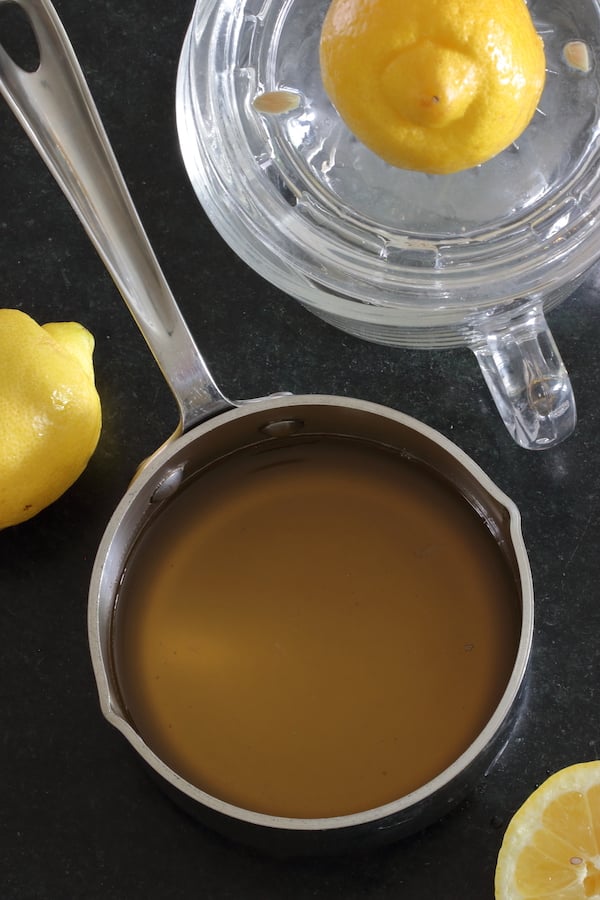
Warm up equal parts water and sweetener (raw honey, real maple syrup, agave, or a variety of crystalized sugar) over medium heat, while stirring, until melted and blended. Remove from the heat, cool down, then refrigerate in a mason jar. Simple syrup will last for about a month if kept in the fridge.
I’ve never tried making a simple syrup with dates, but the idea intrigues me. I plan on experimenting very soon using this recipe posted on the Kitchn.
Simple syrups made with raw honey, real maple syrup, or agave are all sweeter than syrups made with sugar. I find when a recipe calls for 1 cup of sugar simple syrup, I can successfully substitute with 3/4 cup of simple syrup made with raw honey, real maple syrup, or agave.
If you are following a well tested recipe for sorbet, the sugar content should be correct; however, the ripeness/sweetness of fruit can vary, which could effect the recipe. Strive to use fully ripened fruit at its peak level of sweetness.
If you want to be absolutely sure the sugar content is optimal, you can invest in a refractometer – a pro kitchen gadget that measures the concentration of sugar. The goal is to reach a concentration between 20% to 30%.
Then there’s the “egg trick” for measuring the sugar content of sorbet base made with strained fruit juice. It involves floating a raw, clean, fresh egg in the sorbet base. When it’s at the optimal level of sweetness, the egg will float to the top and a bit of the eggshell (the size of a quarter coin) will be visible. Here’s a great video of Chef Thomas Joseph showing how it’s done.
A machine freezes the base quickly and the churning action breaks up ice crystals resulting in a smoother texture. This can also be somewhat accomplished by stirring and mashing the sorbet three or more times while it is freezing – and then stirring and mashing again right before serving. I call this no-churn method “freeze & stir.”
The freezer should be about 0º for optimal results. Put the sorbet in the back of your freezer since it is the coldest location.
Lemon or lime juice is sometimes added to tone down the sweetness. Citrus also helps to keep certain fruits such as peaches and bananas from browning.
Alcohol doesn’t freeze, so it helps prevent sorbet from freezing solid. A little bit goes a long way. 1 to 3 Tablespoons per quart of sorbet is a good rule of thumb. If too much alcohol is added the sorbet will stay mushy.
Alcohol such as brandy, red wine, prosecco, rum, and more is sometimes added simply for the flavor. I personally skip the alcohol and prefer to add healthier ingredients, such as herbal tea.
Alcohol can also be added to sorbet in the form of alcohol based extracts such as vanilla, almond, and chocolate. If adding alcohol based extracts be sure they are all natural, and only add 1/2 to 1 teaspoon per quart of sorbet or their flavor may be overpowering.
Sorbet and sherbet are both fruit based frozen desserts with similar names. There is one big difference. Sherbet contains dairy (or non-dairy milk/cream) and may also contains egg whites, whereas sorbet is dairy-free and contains neither.
It is vegan unless it contains honey.
Yes, as previously mentioned, a simple syrup can be made with equal parts water and honey (or maple syrup or agave). The Easy (no keep) method doesn’t require any added sweetener at all.
How To Make Sorbet WITHOUT an Ice Cream Maker
Three No-Churn Methods
1. Easy (no keep)
Blend frozen fruit in a food processor or blender – with or without sweetener (add a bit of citrus or extract if desired). Eat immediately.
Adding some frozen banana to the mixture makes this “easy (no keep)” sorbet creamier.
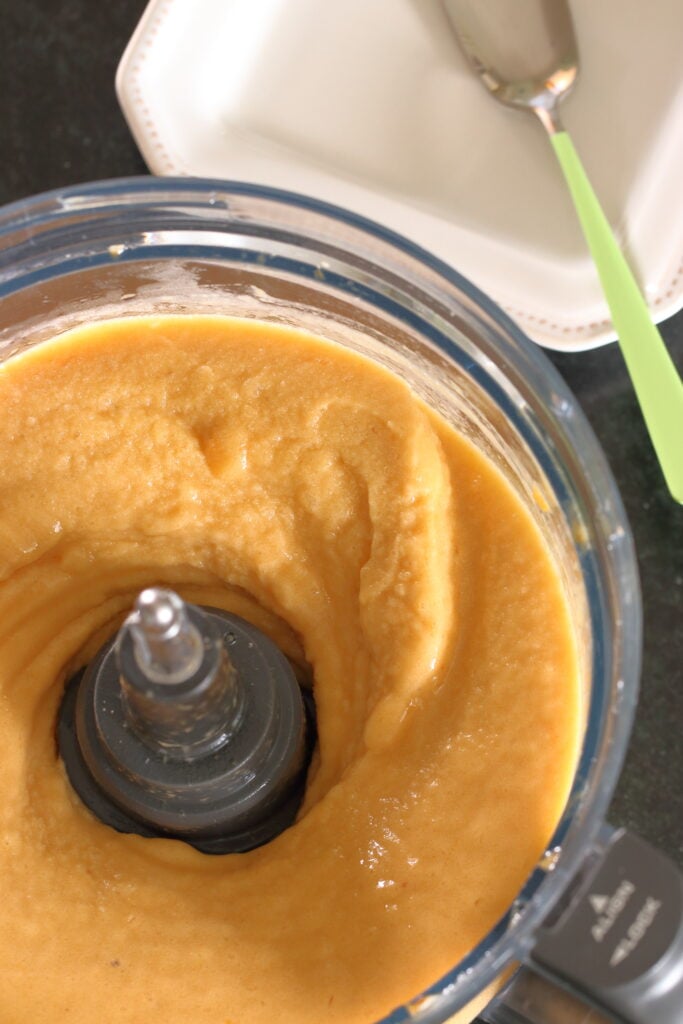

2. Freeze & Stir
Blend fresh or frozen fruit together with simple syrup using a food processor (add a bit of citrus or extract if desired). Spread the sorbet base in a freezer-safe glass loaf pan. Lay a piece of parchment paper on the sorbet to prevent ice crystals from forming, and put into the back of the freezer.
After about 45 minutes, stir and mash the sorbet with the back of a spoon; pay attention to the edges of the container in particular. Put the sorbet back into the freezer and repeat this stirring and mashing process every hour for the next few hours. This will break up ice crystals as they’re forming.
Stir and mash (or blend in your food processor) again right before serving.
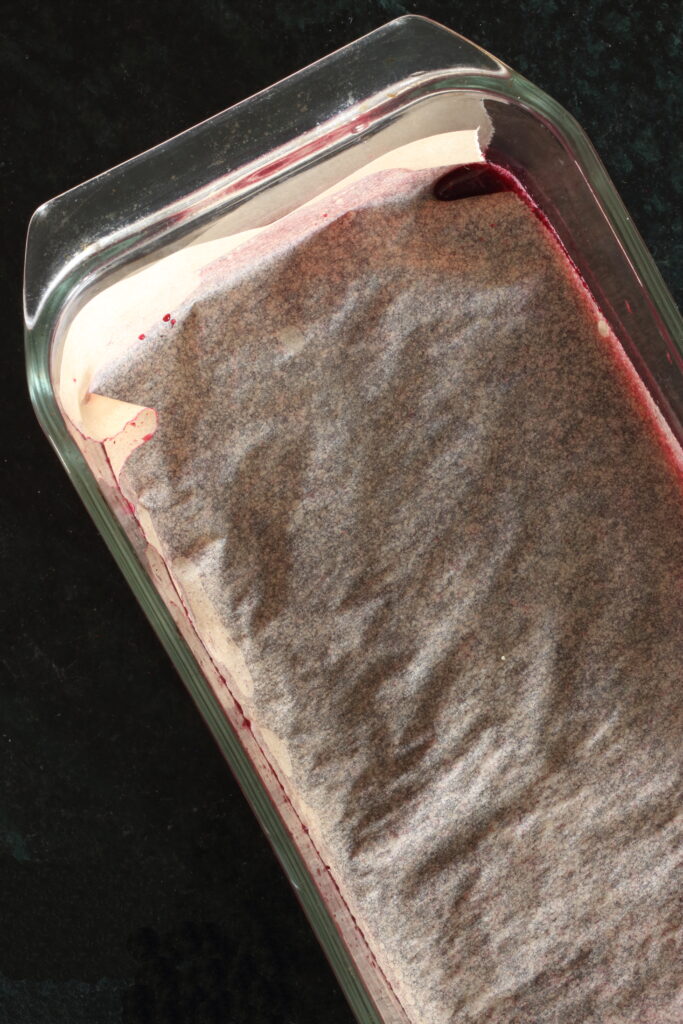

3. Freeze & Blend
Blend fresh or frozen fruit together with simple syrup using a food processor (add a bit of citrus or extract if desired). Spoon the sorbet into ice cube trays and freeze.
When ready to enjoy, pop the sorbet cubes into the food processor and blend; serve immediately. Figure 3 to 4 cubes per serving.
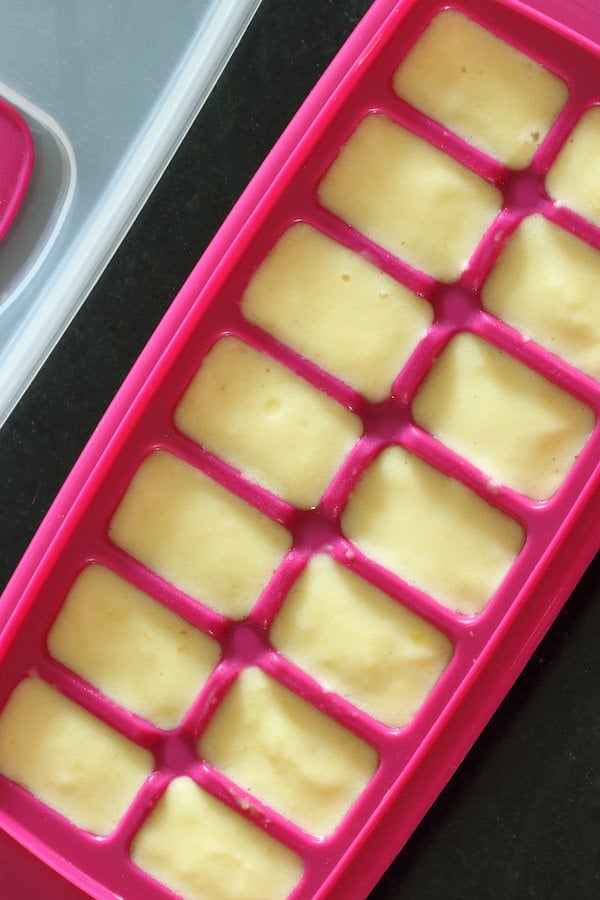

Serving Tip:
Serve sorbet with a chilled scooper
in chilled bowls
Pros & Cons of No-Churn Methods
1. Easy (no-stir)
Pros
- Doesn’t require added sweetener
- Easiest and fastest method
Cons
- Can’t keep in the freezer; if frozen it will be full of ice crystals and too hard to scoop
- Melts the fastest of all the methods (consistency is similar to a very thick smoothie)
2. Freeze & Stir
Pros
- Creates a scoopable sorbet that can be kept in the freezer
Cons
- The stirring helps prevent the formation of large ice crystals, but some may still form
- Requires attention while it’s freezing
3. Freeze & Blend
Pros
- Fairly easy method
- Creates a scoopable sorbet
Cons
- The cubes need to be blended again in the food processor right before serving
If your sorbet has melted or become icy, simply reprocess using the method of your choice and it will bounce back.
How to Make Sorbet WITH an Ice Cream Maker (Churn-Method)

Method Overview
- Freeze the ice cream maker’s canister (bowl that the sorbet is churned in) for 12 to 24 hours
- Make a simple syrup in advance; refrigerate
- Blend fruit (fresh or frozen) and simple syrup in food processor or blender; refrigerate mixture until well chilled
- Churn the chilled mixture for 15 to 20 minutes, following manufacturer’s directions
- Put sorbet in freezer for at least two hours before serving
Churn-Method Tips for Success
Listen, I want you to be successful at making sorbet with an ice cream maker. Making sorbet this way is not difficult, but there are a few things you need to take seriously in order to get it right. Sorbet with large ice crystals or a soupy consistency is what you want to avoid.
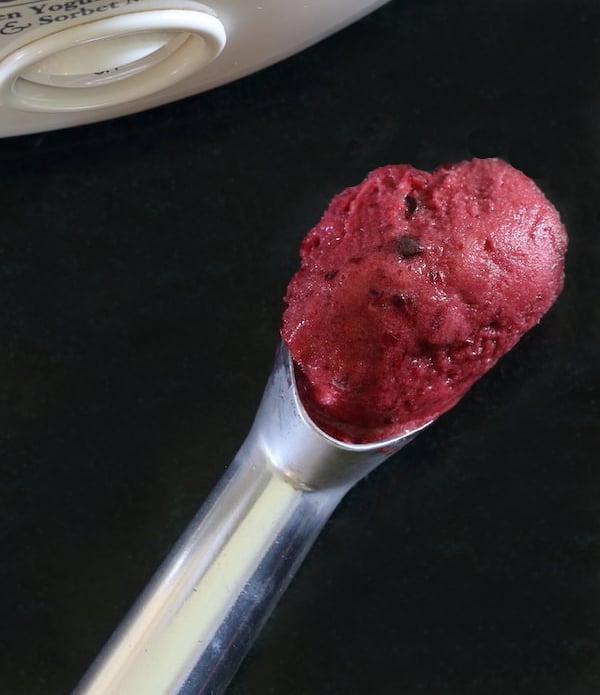
Perfect scoopable consistency made with 4 cups Woodstock sweet cherries, 3/4 cup honey simple syrup, 1/2 teaspoon pure vanilla extract, 3 Tablespoons bittersweet chocolate chips. Hibiscus tea was used in place of water when making the simple syrup.
- Re-read the manufacturer’s directions for your particular ice cream maker especially if you haven’t used it in a while.
- Always start with a fully frozen canister so the liquid coolant surrounding the canister is frozen solid. Shake the canister, if you hear sloshing, then it isn’t ready. Pre-freezing the canister will take between 12 to 24 hours. Your freezer should be set to 0ºF or lower; place the canister in the back of your freezer where it is coldest.
- Your fruit and simple syrup mixture should be very well chilled before you process it. If you’re starting with frozen fruit and pre-chilled simple syrup, this step won’t take that long. Otherwise, plan on refrigerating your mixture for several hours, or even overnight, before churning.
- Use enough simple syrup or you may end up with an icy sheet of sorbet instead of a scoopable consistency.
- After it’s processed, freeze the sorbet for about two hours before serving, unless you prefer a soft-serve consistency.
Pros & Cons of Using an Ice Cream Maker
Pros
- Sorbet has the best consistency; creamy, smooth, scoopable
- Can be stored in the freezer and scooped when desired
- Requires some pre-planning but otherwise it’s a fairly easy straightforward method
Cons
- Requires the use of an ice cream maker
- Need to freeze the canister 12 to 24 hours in advance
- The sorbet base and simple syrup need to be fully chilled before churning
More Tips for Making Sorbet (Any Method)
Types of Fruit
Sorbet can be made with any type of fruit or fruit juice. Again strive to use only fully ripened fruit at its peak level of sweetness. Fruits (and vegetables) can also be blended together to create interesting flavor combinations.
Some fruits (such as pears, apples, rhubarb, cranberries) should be cooked first for best results. Simply simmer with a bit of water over medium-high heat until soft, then cool. Use the water that the fruit was cooked in when making the simple syrup.
Savory Sorbets
So far I’ve only experimented with sweet fruit sorbets but you can also make them with savory fruits such as tomatoes, cucumbers, avocados – and vegetable juices such as celery, pepper, carrot, and beet. Sorbet can even be made with herbal teas, coffees, and chocolate.
How to Deal with Seeds and Skins
Berry sorbets comes out smoother if you first remove the seeds. There are two ways to accomplish this. You can use a food mill, such as the OXO food mill to strain the seeds. Or you can blend the berries with a bit of water, and then strain using a fine mesh strainer.
As far as skins go, it depends on the fruit. I don’t strain or peel the skins from peaches and cherries. They add nutritional value and I enjoy the flecks of color and texture. I imagine that the skins could also be left on seedless grapes, apricots, pears, and plums. Apple and kiwi skins are too thick and would ruin the consistency and should be peeled or strained. For obvious reasons peel inedible skins such as pineapples, bananas, mangos, paw paws, and the like.

Flavoring with Herbal Teas
Herbal teas such as hibiscus, rose hips, ginger, lemon balm, mint, and more can be used in place of water when making the simple syrup. Doing so ramps up the nutritional value in addition to creating interesting flavor combinations.
Citrus
As mentioned earlier – a bit of citrus juice tones down the sweetness, adds bright flavor, and also helps to keep certain fruits from browning. 1 or 2 Tablespoons per quart is a good rule of thumb. Lemon, orange, or lime zest can also be added to the sorbet base.
Additional Ingredients
Sorbet is usually smooth devoid of additional ingredients. But sometimes I enjoy adding a bit of bittersweet chocolate chips, shredded coconut, or minced dried fruits 😉
Containers for Freezing/Storing Sorbet
- For churned sorbet, I recommend using 1 quart freezer safe glass containers with BPA-free snap on lids.
- For “freeze & stir” sorbet I recommend using freezer-safe glass loaf pans. When sorbet is frozen in a loaf pan, it is spread out and freezes faster than it does in a smaller deep container.
- For “freeze & blend” sorbet I recommend using a BPA-free covered ice cube tray, such as Joie brand.
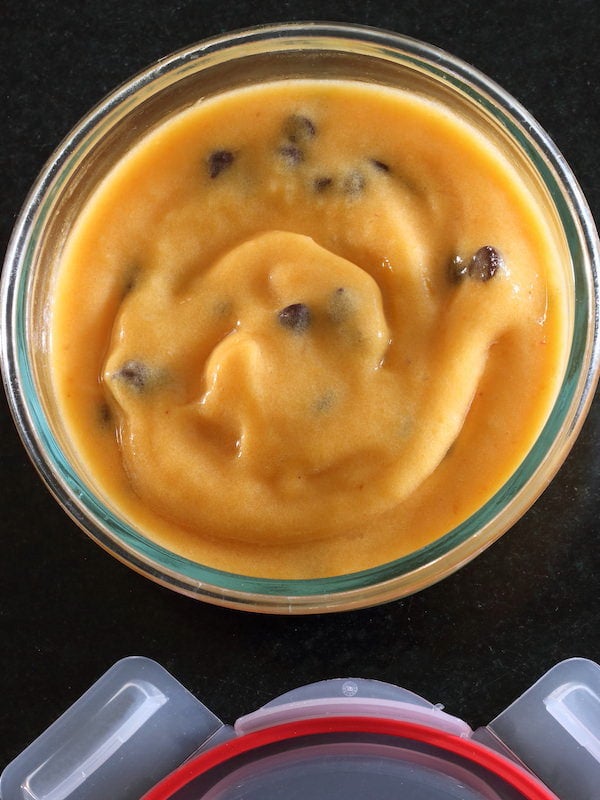
with snap-on lid

If you enjoyed this post check out another I wrote called Perfect Peach Sorbet.

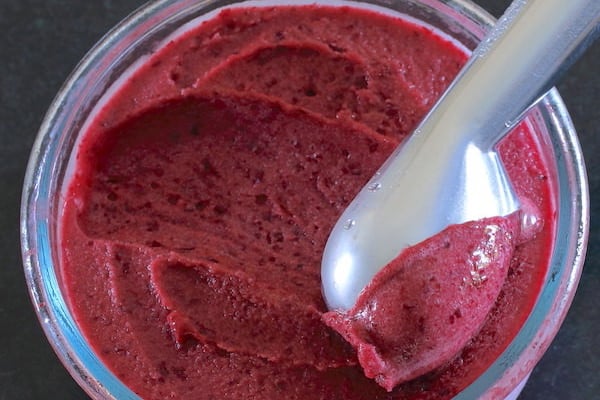
Great article.|
Thanks! I appreciate it.
So helpful! Great suggestions, thank you.
You’re welcome!
This is a great post! Thank you! What is the fruit to sugar-syrup ratio you generally stick to?
Hi Robyn and thanks for your kinds words 🙂 This is a good but tricky question since it depends on the sweetness of the fruit being used (I assume you’re referring to when making a traditional churned recipe). In my Peach Sorbet recipe, as an example, I use a 1:4 ratio – 1 cup of simple syrup to 4 cups of sliced peaches. But if the fruit used is sweeter, you may be able to reduce the amount of simple syrup – and if the fruit used it tarter, more simple syrup may be needed. https://alifewellplanted.com/10824/sugar-free-peach-sorbet/
I suggest taking the information you learned through this post and applying it to a recipe that gives the ratio for the particular fruit being used. The good news is – if you don’t use enough simple syrup and don’t like the way it turns out after going through the whole process of churning and freezing, you can always add more simple syrup and reprocess it.
Thank you so much! And I had assumed as much… wish me luck on my first attempt! Xx
Good luck and let us know how it turns out!
Hi!
Maybe a bit of stupid question, but some say 1:4 so 1 cup of sugar to 4 cups of fruit. (And then add 1 cup of water). If you say 1 cup of simple syrup, that isn’t the same as 1 cup of just sugar right, as sugar dissolved in water will have a different measurement?
Hi Linda,
You are correct, 1 cup of simple syrup is not the same as 1 cup of sugar.
I explain how to make simple syrup under the FAQs.
Is it possible to make a simple syrup for sorbet in an ice cream maker using Stevia? Is it possible to replace the sugsr for diabetics?
Hi Bonnie. If you’re trying to make a no sugar recipe, try the “Easy, No Keep” instructions in my blog post.
I use a sorbet stabilizer and the ice crystals don’t form.
Hi Ray,
What are the ingredients in the stabilizer?